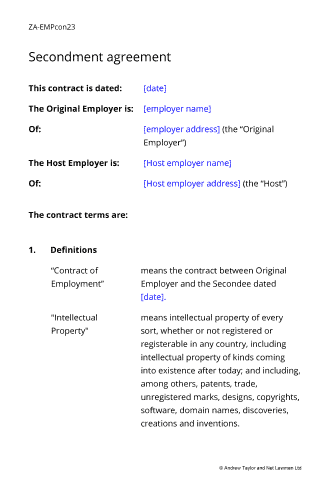Secondment agreement

Document overview


- Length:6 pages (1750 words)
- Available in:
 Microsoft Word DOCX
Microsoft Word DOCX Apple Pages
Apple Pages RTF
RTF

If the document isn’t right for your circumstances for any reason, just tell us and we’ll refund you in full immediately.

We avoid legal terminology unless necessary. Plain English makes our documents easy to understand, easy to edit and more likely to be accepted.

You don’t need legal knowledge to use our documents. We explain what to edit and how in the guidance notes included at the end of the document.

Email us with questions about editing your document. Use our Lawyer Assist service if you’d like our legal team to check your document will do as you intend.

Our documents comply with the latest relevant law. Our lawyers regularly review how new law affects each document in our library.
About this document
A secondment usually requires two documents: an amendment to the secondee’s employment contract to allow him or her to be seconded, and a contract between the original employer and the new employer (the “host”) setting out the terms of the secondment. We have included both in this pack.
The essence of secondment is that the secondee works exclusively for another organisation, usually for a fixed period. Importantly, under current employment law, the original employer continues to carry all the legal obligations relating to the employment including the risk of an application to an employment tribunal resulting from an act or omission by the host, or some accident while the secondee is at work for the host.
Because liability for the employment contract remains with the original employer, this agreement is designed as far as possible to protect him against failure by the host to comply with both the contract of employment and the general law. It also guards the intellectual property rights of both organisations.
The law in these documents
There is little law regulating secondment, but the legal implications of secondment on employment law are huge. It is therefore essential that the original employer and the host agree the terms of the secondment in as much detail as possible.
Our secondment agreement has been drawn to include all the basic arrangements you will need. You can easily add, edit or remove provisions to suit your arrangement.
When to use this document
Our secondment agreement can be used by organisations of any size or in any industry. Since the original employer faces most risk from a secondment, we suggest that it is he or she that suggests the terms in the first instance.
It is possible to draw a single agreement between all three parties. However, because one agreement may contain terms confidential to only two of the parties (such as how much the original employer will receive in consideration of the secondment) we have structured the agreement as two documents.
By listing the terms of the secondment in a schedule you have total flexibility on what work the secondee will do, and all three parties know what is expected.
Document features and contents
Some of the paragraphs in the agreements deal with similar matters, others are unique to the arrangement between two of the three parties. Together the documents consider:
Basic practical terms
Confirms the secondment of the secondee to the host organisation.
Identity of the host and negation of original employer’s liability for the nature of work
The paragraphs confirm what or who exactly is the host and what is the nature of its business. The secondee accepts that the original employer is not responsible if the nature of the work is not as the secondee expects.
Terms and termination of secondment
Sets out the term of the contract and the conditions under which it can be terminated.
Continuing duty of the employee to the employer
Reminds the secondee that he or she remains an employee of the original employer throughout the secondment
Expenses and changed entitlements
These paragraphs cover how the secondee will be reimbursed for expenses during the secondment, and how his or her benefits and entitlements under the original employment agreement change as a result of the secondment.
Obligations of the employer and host to each other and to the secondee
This section ensures that the host abides by rights that the secondee has under the original employment agreement (so far as they cannot be changed by the secondment) and takes responsibility for the expenses of employment (excluding salary).
Non competition provision to safeguard employer’s business
The section covers the very difficult area of non-compete during and after the secondment. If the host has similar clients to the original employer then either party may want to ensure that customer poaching does not occur as an unintended consequence of the secondment.
Indemnity by host
While the original employer remains liable for the wellbeing of the secondee throughout the secondment, this indemnity protects the original employer from the cost of failures by the host to comply with the law.
Intellectual property rights
This section grants the original employer ownership and benefit of any intellectual property that the secondee creates. Of course you can change this to give the benefit to the host.

Recent reviews
Choose the level of support you need
Document Only
This document
Detailed guidance notes explaining how to edit each paragraph
Lawyer Assist
This document
Detailed guidance notes explaining how to edit each paragraph
Unlimited email support - ask our legal team any question related to completing the document
- Review of your edited document by our legal team including:
- reporting on whether your changes comply with the law
- answering your questions about how to word a new clause or achieve an outcome
- checking that your use of defined terms is correct and consistent
- correcting spelling mistakes
- reformatting the document ready to sign
All rights reserved
